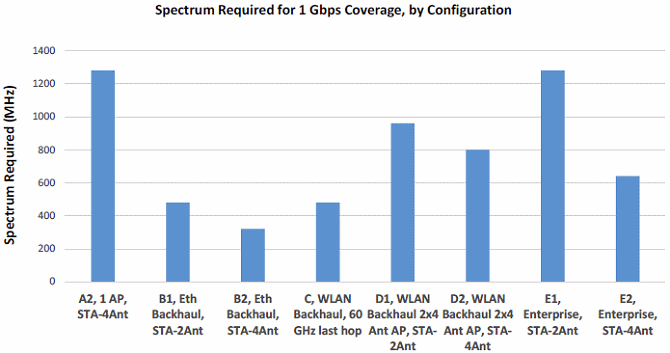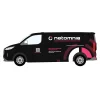WiFi Needs 1280MHz of 5GHz Spectrum for “Whole Home” 1Gbps Speed
A recent study from Qualcomm Technologies has concluded that home WiFi (WLAN) wireless networks will need more than double the current amount of radio spectrum (around the 5GHz band) to deliver “sustained” speeds of 1Gbps (1000Mbps+) throughout an entire home.
At present plenty of router manufactures already claim to offer multi-Gigabit speeds using the 802.11ac standard via the 5GHz and 2.4GHz bands, although in reality such speeds are rarely achieved unless you’re sitting right on top of the router. Performance tends to fall away when more users connect or you move into a different room / level of the building.
Advertisement
This represents a problem, not least because many ISPs around the world are deploying “ultrafast” fixed line broadband connections that can deliver speeds of 1Gbps or faster (these often use fibre optic FTTH/P technology). In keeping with that ISPs are starting to demand that router manufacturers offer “whole home 1Gbps coverage“, which is easier said than done.
Qualcomm’s analysis covered a variety of networking topologies/configurations for a dense residential scenario with either 2 or 4 antennas at the device/client side (STA), such as several that required 4 access points (AP) per apartment (with four rooms) and a few that used 60GHz WiGig technology for the short-range “last hop” communication.
Most people will of course prefer to use a single AP (e.g. your broadband router) to do everything, but Qualcomm found that the target of 1Gbps coverage of the apartment in a dense residential setting “could not be met with a single AP and a 2 antenna STA“.

According to the research, full 5GHz WLAN implementation configurations with a 2+ antenna STA indicate a requirement for a minimum of around 1280MHz of spectrum (Configurations D1, E1). Now that’s a problem because the amount of 5GHz spectrum that is currently available for unlicensed technologies today is 450MHz in Europe and 580MHz in North America.
Advertisement
Ofcom are of course hoping to give WiFi a boost in the United Kingdom by proposing to add an extra sub-band to 5GHz, which would increase the number of 80MHz channels available from 4 to 6 and thus deliver faster speeds (here). However this merely puts us more or less level with North America, which still leaves a big gap to fill.
1. To enable future WLAN-type application and usage scenarios, regulators should plan for around 1280MHz of unlicensed spectrum centred around the 5GHz band for use by unlicensed technologies, to enable common deployment scenarios such a single access points for apartments (Configuration A) and 2 antenna client devices in dense enterprise settings (Configuration E).
2. Higher throughput coverage scenarios in dense environments require extensive use of 160MHz channel bandwidth modes; regulators should strive towards making multiple (i.e. 3 or more) 160MHz wide channels available for unlicensed use.
3. Service providers, consumer electronics vendors, networking vendors and building construction companies should adopt topologies of 1 AP per room (including combo APs with 60GHz mmWave technology)
4. Device vendors should adopt 2 or more spatial stream capable radios in future product designs and 60GHz mmWave technology where possible.
Figuring out how to free up all of that spectrum and harmonise the policy is something that regulators from around the world are already in the process of examining, although such things rarely happen quickly.
Meanwhile the Wi-Fi Alliance are working on the next generation of WiFi known as 802.11ax MAC/PHY technology, which can deliver 10Gbps via the 5GHz band in busy environments (details). But we don’t expect to see that in the commercial market until around 2018/19.
Mind you it’s worth remembering that being able to deliver such speeds via your router is one thing, but having devices, applications and an Internet connection that can actually make use of it is another ball game entirely.
Advertisement
Mark is a professional technology writer, IT consultant and computer engineer from Dorset (England), he also founded ISPreview in 1999 and enjoys analysing the latest telecoms and broadband developments. Find me on X (Twitter), Mastodon, Facebook, BlueSky, Threads.net and Linkedin.
« Sky UK and BT Chiefs Spar Over Openreach’s Future and Broadband
















































Comments are closed